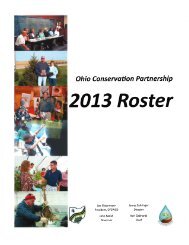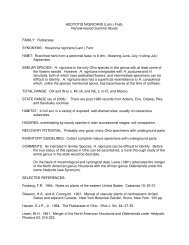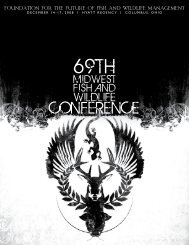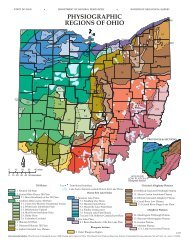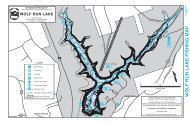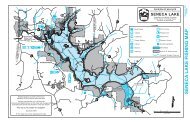EL 6, Flint 8.5X11.indd - Ohio Department of Natural Resources
EL 6, Flint 8.5X11.indd - Ohio Department of Natural Resources
EL 6, Flint 8.5X11.indd - Ohio Department of Natural Resources
Create successful ePaper yourself
Turn your PDF publications into a flip-book with our unique Google optimized e-Paper software.
FLINT<br />
<strong>Ohio</strong>’s Offi cial<br />
Gemstone<br />
by Garry L. Getz<br />
Educational Leafl et No. 6<br />
Revised Edition 2012<br />
<strong>Flint</strong>: <strong>Ohio</strong>’s Offi cial Gemstone<br />
1<br />
Throughout <strong>Ohio</strong>’s early history, humans relied<br />
on tools created from a large variety <strong>of</strong> stone<br />
materials. Th ey preferred stone that could<br />
be easily fashioned into tools in a timely manner by<br />
fl aking. Th e most common stone used in prehistoric<br />
time was fl int. An important resource for making<br />
tools and weapons, fl int was valued because it broke<br />
sharply in conchoidal fractures. tures. <strong>Flint</strong> is<br />
a strong, durable stone that hat can caan<br />
be<br />
easily reshaped; thus it was th the he<br />
preferred material for toololmaking. <strong>Ohio</strong> has a variety<br />
<strong>of</strong> stone materials that<br />
can be easily chipped or<br />
fl aked, including chert,<br />
chalcedony, jasper, and<br />
agate, all <strong>of</strong> which are<br />
Conchoidal<br />
fi nely crystalline, siliceous us<br />
fractures<br />
materials that are <strong>of</strong>ten<br />
referred to under the generic neric<br />
name <strong>of</strong> fl int. What most people call fl int is technically<br />
chert. However, true fl int is found only in very specifi c<br />
places around the world (e.g., Cretaceous chalks <strong>of</strong><br />
England). <strong>Flint</strong>, a variety <strong>of</strong> quartz, is composed <strong>of</strong><br />
silicon dioxide (SiO2) or silica. Essentially, fl int is a<br />
more pure form <strong>of</strong> chert, both having similar physical<br />
properties. For example, chert and fl int both occur as<br />
nodules and in layers or beds.<br />
<strong>Ohio</strong> is fortunate to have sources <strong>of</strong> some <strong>of</strong> the<br />
most highly prized fl int in the world, sought after by<br />
collectors, lapidarists, and artists.<br />
Occurrence <strong>of</strong> <strong>Flint</strong> in <strong>Ohio</strong><br />
Sources <strong>of</strong> fl int range from layers found in bedded<br />
limestone to materials that were carried by glaciers<br />
and tumbled about, taking the form <strong>of</strong> rounded<br />
cobbles. In <strong>Ohio</strong> fl int occurs in a wide range <strong>of</strong> strata<br />
extending from the Brassfi eld Limestone in the basal<br />
portion <strong>of</strong> the Silurian (443.7–416 million years<br />
[m.y.] ago) to the Cambridge limestone in the lower<br />
half <strong>of</strong> the Conemaugh Group <strong>of</strong> the Pennsylvanian<br />
System (418.1–299 m.y. ago). Th ese rocks were<br />
deposited in shallow, tropical seas that covered the<br />
area that is now <strong>Ohio</strong> during the Paleozoic Era.<br />
Most fl int deposits are associated with marine<br />
limestone. Th ere is no defi nitive answer as to the<br />
source <strong>of</strong> the vast quantities <strong>of</strong> silica necessary to<br />
form fl int deposits in <strong>Ohio</strong>. Although fi nal answers<br />
have not been determined, the consensus today
T 319<br />
T 317<br />
FRANKLIN<br />
TOWNSHIP<br />
T 310<br />
T 318<br />
C 312<br />
T 340<br />
40<br />
C 668<br />
T 288<br />
T 335<br />
T 340<br />
T 283<br />
FLINT<br />
is that most nodular chert forms by the replacement <strong>of</strong><br />
limestone by silica and that bedded chert forms by either<br />
the complete replacement <strong>of</strong> carbonate-rich beds or the<br />
alteration <strong>of</strong> siliceous ooze, which in part derived from<br />
spicules that formed the skeletal support for sponges that<br />
lived in the seas.<br />
Th e most famous deposit <strong>of</strong> <strong>Ohio</strong> fl int, the<br />
Pennsylvanian-age Vanport fl int, is found in an area <strong>of</strong><br />
eastern Licking and western Muskingum counties known<br />
as <strong>Flint</strong> Ridge. <strong>Flint</strong> Ridge fl int has been quarried for over<br />
12,000 years and covers a ridge-top area <strong>of</strong> about six square<br />
miles. One <strong>of</strong> the most impressive and areally extensive<br />
concentrations <strong>of</strong> ancient quarries is located at <strong>Flint</strong> Ridge<br />
and within <strong>Flint</strong> Ridge State Memorial (see below). Here<br />
the fl int deposit ranges in thickness from one foot to twelve<br />
feet and is believed to be discontinuous in areas.<br />
<strong>Flint</strong> Ridge fl int is noted for its array <strong>of</strong> colors and<br />
widespread use by Native Americans. Th e fl int <strong>of</strong> the<br />
Vanport member varies greatly in color and quality at<br />
diff erent portions <strong>of</strong> the deposit. Much <strong>of</strong> it is a typical<br />
chalcedony—a dense, fi brous, microcrystalline variety<br />
T 289<br />
T 355<br />
C 668<br />
C 668<br />
T 290<br />
<strong>Flint</strong>: <strong>Ohio</strong>’s Offi cial Gemstone<br />
T 285<br />
RIDGE<br />
Brownsville<br />
T 291<br />
T 291<br />
HOPEW<strong>EL</strong>L<br />
TOWNSHIP<br />
ROAD<br />
2<br />
C 339<br />
T 278<br />
C 312<br />
Gratiot<br />
T 278<br />
T 277<br />
T 292<br />
COUNTY<br />
COUNTY<br />
LICKING<br />
MUSKINGUM<br />
Map <strong>of</strong> the <strong>Flint</strong> Ridge area, Licking and Muskingum Counties.<br />
40<br />
C 1<br />
C 8<br />
T 122<br />
C 412<br />
C 8<br />
HOPEW<strong>EL</strong>L<br />
TOWNSHIP<br />
C 8<br />
T 291 Township road<br />
C 8<br />
40<br />
C 8<br />
Vanport flint<br />
C 8<br />
0 1 mile<br />
0 1 kilometer<br />
T 292<br />
T 122<br />
T 609<br />
T 413<br />
Native American quarry<br />
<strong>Flint</strong> Ridge State Memorial<br />
County road<br />
U.S. route<br />
<strong>of</strong> quartz—usually blue or grayish blue and translucent.<br />
Portions <strong>of</strong> the deposit are banded or ribbon jasper—a<br />
characteristically red chert—with alternating strips <strong>of</strong><br />
light and dark gray. In the central part <strong>of</strong> the ridge the<br />
deposit has weathered to various tints <strong>of</strong> blue, red, brown,<br />
yellow and white. Th e rarer colors are green, bright yellow,<br />
red, blue, and purple and swirled, streaked, and mottled<br />
combinations <strong>of</strong> these. Th e color variegation in <strong>Flint</strong> Ridge<br />
fl int is typically caused by chemical impurities. Th e most<br />
important staining or coloring agents are iron, manganese,<br />
and carbonaceous materials. Surface weathering and<br />
subsurface oxidation by the action <strong>of</strong> circulating waters are<br />
additional factors that may aff ect color.<br />
Th e exceptional characteristics <strong>of</strong> <strong>Flint</strong> Ridge fl int<br />
distinguished it from other cherts found in the <strong>Ohio</strong> River<br />
Valley and explain why it was so important to prehistoric<br />
Native Americans. Th e high quality <strong>of</strong> this fl int may have<br />
been what attracted the earliest hunting and gathering<br />
groups to quarry it for making large spear points, but its<br />
bright and varied colors may have been more important to<br />
later Woodland peoples. Th e Adena (circa 850–50 b.c.) and
WILLIAMS FULTON<br />
TON<br />
LUCAS LUC CAS<br />
DEFIANCE<br />
NCE<br />
PAU PAULDI PAU PA PAULDING INGG<br />
VAN WE WERT ERT<br />
MERCER ERCER R<br />
HENRY<br />
PU PUTN PUT PUTN PUT PUTN PUT PUTN PU PUT PUTN PUT PUTN PUT PU PUTN P PUT PUTN PU PUTN PUT PU P PPUTNAM UTN UT UTN UT UTN UUT<br />
UTN UT UTN U UTN TN TTN<br />
T TN TNAM N AM<br />
Upper Mercer flint<br />
Vanport flint<br />
Zaleski flint<br />
ALLE ALL AL ALLE ALL ALLE ALL ALLE ALL ALLE ALL ALLE AL ALLE ALL ALLE AL ALL ALLE ALL ALLE ALL ALLE ALL ALLE AL ALLE AL ALL ALLE ALL ALLE ALL ALLE AL ALLE A AALLEN LLE LLLE<br />
LL L LLLE LE LLE<br />
LEN E<br />
BROWN BROW<br />
HA HANC HAN HANC HAN HANC HAN HANC HAN HANC HAN HA HAN HANC HAN HANC HA HAN HANC HAN HA HAN HANC HA HANC HAN HANC HAN HANC HAN HANC HAN HANC HAN HANC HA HANC HA HAN HA HANC HA HANC HAN HA H HANC HANCOC HANCOCK ANC AN ANC NC N NC C OC O CK C<br />
HARDIN HARD HAR HARD HAR HARD H HARD H HAARD AR ARD RD R IN<br />
<strong>Flint</strong>: <strong>Ohio</strong>’s Offi cial Gemstone<br />
<strong>Flint</strong> Locations and Bedrock Geology<br />
BROWN Zaleski Zalesk<br />
aleski ski flint fl flint int<br />
SC SCI SC SCIOTO<br />
Permian-Pennsylvanian<br />
Pennsylvanian<br />
LICKING L<br />
FAIRFI<strong>EL</strong>D<br />
VINTON<br />
JACKSON<br />
3<br />
ASHLAND<br />
ASH AASH ASHL AS A SHL HL HLAN<br />
AND A AND AN ND WAYNE WA WAYN WA WAYN WA WAYN WAY WAYN WA WAY WA WAY WA W AY YNE YYNE<br />
Vanport nport rt flint fl int with<br />
h<br />
quartz crystals<br />
PERRY<br />
HOCKING<br />
LAWRENCE<br />
Explanation<br />
GALLIA<br />
HOLMES<br />
COSHOCTON<br />
MUSKINGUM<br />
ATHENS<br />
MEIGS<br />
Devonian<br />
MORGAN<br />
Mississippian<br />
TUSCARAWAS<br />
GUERNSEY<br />
NOBLE<br />
WASHINGTON<br />
CARROLL<br />
HARRISON<br />
ASHTABULA<br />
MAHONING<br />
COLUMBIANA<br />
B<strong>EL</strong>MONT<br />
MONROE<br />
Silurian<br />
Ordovician<br />
JEFFERSON<br />
0 40 miles<br />
0 50 kilometers<br />
Fault
Hopewell (150 b.c.–a.d. 450) peoples quarried this fl int for<br />
both utilitarian and ceremonial objects and traded this fl int<br />
with other contemporary groups throughout the region.<br />
<strong>Ohio</strong>’s Native Americans also quarried fl int from<br />
deposits other than <strong>Flint</strong> Ridge, most notably the Zaleski<br />
fl int in Vinton and Jackson counties and the Upper Mercer<br />
fl int in Coshocton, Hocking, and Perry counties. Like <strong>Flint</strong><br />
Ridge, these units are Pennsylvanian in age.<br />
Role <strong>of</strong> <strong>Flint</strong> in <strong>Ohio</strong> History<br />
<strong>Ohio</strong>’s fi rst human inhabitants, or Paleo-Indians,<br />
migrated from the west and slowly inhabited the land as<br />
the last <strong>of</strong> the glaciers receded about 15,000 years ago. Th e<br />
migration took place over thousands <strong>of</strong> years as forays after<br />
game ranged further and further afi eld and led gradually to<br />
permanent habitation <strong>of</strong> new territories. Survival <strong>of</strong> early<br />
humans was predicated on four basic requirements: water<br />
for drinking, cooking, and transportation; wood for fi res,<br />
tools, and shelter; wild game for food and clothing; and fl int<br />
for a variety <strong>of</strong> stone tools, weapons, and other implements.<br />
Th roughout the development <strong>of</strong> prehistoric people,<br />
fl int was the most utilized rock type. It was fashioned by<br />
early hunters into spear points, knives, hide scrapers, drills,<br />
and a variety <strong>of</strong> other implements for daily and ceremonial al<br />
use. Survival in prehistoric <strong>Ohio</strong> was directly linked to o the<br />
eff ectiveness <strong>of</strong> stone tools <strong>of</strong> early humans.<br />
Recent research by Th e <strong>Ohio</strong> State University and<br />
<strong>Ohio</strong> Historical Society archaeologists suggests that<br />
some Native Americans came to <strong>Flint</strong> Ridge to replace<br />
their worn out and broken points and artifacts, not to<br />
produce large quantities <strong>of</strong> stone tools for trade. Th e<br />
Native Americans recycled their chipped or broken stone<br />
tools by resharpening and using them again. When bodies<br />
<strong>of</strong> reworked points became too narrow to function as<br />
weapons, they were further fl aked down into drills. Native<br />
Americans who discovered artifacts from previous times<br />
reworked these tools and weapons too. In each <strong>of</strong> the<br />
prehistoric time periods, Native Americans made new<br />
tools to meet changing needs, improve existing versions,<br />
and become even more skilled in working stone. During<br />
long spans <strong>of</strong> time there were gradual, distinct changes in<br />
the way Native Americans lived. Th ese changes were <strong>of</strong>ten<br />
refl ected in the kinds <strong>of</strong> tools and weapons they used and<br />
how the objects were made.<br />
Native Americans used fl int drills such as this to drill<br />
holes in wood and bone. Actual size.<br />
ohio historical society photo<br />
<strong>Flint</strong>: <strong>Ohio</strong>’s Offi cial Gemstone<br />
4<br />
Th is Th ebes type projectile point<br />
was resharpened and probably was<br />
used as a knife. Actual size.<br />
ohio historical society<br />
photo<br />
St. Charles type projectile point made<br />
from <strong>Flint</strong> Ridge fl int. Actual size.<br />
ohio historical society photo<br />
Originally a projectile point, this<br />
scraper tool was fashioned after the<br />
original tip broke. Actual size.<br />
ohio historical society photo
<strong>Flint</strong>: <strong>Ohio</strong>’s Offi cial Gemstone<br />
Example <strong>of</strong> an early<br />
fl intlock rifl e mechanism.<br />
<strong>Ohio</strong> fl ints were not <strong>of</strong> high<br />
enough quality for fl intlock<br />
production.<br />
Th is millstone, which has been used as a headstone in a Knox<br />
County cemetery, was made from Vanport fl int. Note the<br />
furrowed, polygonal pieces fi tted together and secured with a<br />
metal strap. Diameter approximately 3.5 feet.<br />
joe hannibal photo<br />
5<br />
<strong>Flint</strong> was also important to <strong>Ohio</strong>’s European settlers,<br />
who used impure, porous deposits <strong>of</strong> fl int for buhrstones<br />
to grind grain in their water mills and for grindstones<br />
to sharpen tools. Some buhrstones measured 4–7 feet in<br />
diameter and 1–1.5 feet in thickness and regularly sold for<br />
several hundred dollars per pair. Smaller, hand-powered<br />
grinding wheels were also made for home use. Th e town<br />
<strong>of</strong> McArthur, in Vinton County, was noted for such a<br />
product. Here the industry began about 1807, relying on the<br />
Vanport fl int, and continued vigorously for over 35 years.<br />
Another active fi eld for buhrstones during the early period<br />
<strong>of</strong> development was <strong>Flint</strong> Ridge, where Vanport fl int was<br />
utilized also in this way. Quarrying <strong>of</strong> fl int buhrstones in<br />
<strong>Ohio</strong> continued until approximately 1840. <strong>Flint</strong> also was<br />
used for fi re starting and in fl intlock rifl es <strong>of</strong> the pioneers,<br />
though some reports state that <strong>Ohio</strong> fl ints were not <strong>of</strong> high<br />
enough quality for fl intlock production. Other uses included<br />
glazing for ceramics and to enamel glassware manufactured<br />
in the Zanesville area.<br />
The Use <strong>of</strong> <strong>Flint</strong> Today<br />
Over the last several decades there has been a renewed<br />
interest in fl int materials, not just in <strong>Ohio</strong> but across the<br />
United States. Because <strong>of</strong> its color, hardness, and ability<br />
to take a high polish, <strong>Flint</strong> Ridge fl int is one <strong>of</strong> the most<br />
coveted materials among mineral collectors and lapidarists,<br />
who produce unique, <strong>of</strong>ten beautiful jewelry items from this<br />
rock. Th us in 1965 the <strong>Ohio</strong> General Assembly named fl int<br />
<strong>Ohio</strong>’s <strong>of</strong>fi cial gemstone.<br />
An additional modern day use for fl int is fl intknapping.<br />
<strong>Flint</strong>knapping is a highly descriptive term, referring to both<br />
the raw material (fl int) and the manufacturing process<br />
<strong>of</strong> knapping, which means “breaking with sharp blows.”<br />
Th e breaking process also is commonly known as fl aking.<br />
<strong>Flint</strong>knapping can be traced further back in time than<br />
any other technology. Th e process is accomplished with<br />
a multitude <strong>of</strong> techniques and tools. Th e basic approach<br />
involves reducing the volume <strong>of</strong> a stone by removing fl akes.<br />
<strong>Flint</strong>knapping is one <strong>of</strong> two technological innovations that<br />
greatly aff ected the course <strong>of</strong> human development; the other<br />
is controlled use <strong>of</strong> fi re.<br />
As a hobby, fl intknapping quickly has grown over<br />
the past 25 years. During the last 10–15 years a growing<br />
appreciation for fi nely crafted, fl intknapped art pieces has<br />
developed. In 2004 the Lithic Artists Guild was created<br />
to promote modern lithic art as a legitimate art form. Th e<br />
guild gives recognition to artists who have mastered the<br />
lithic process. Today many knappers are making their points<br />
out <strong>of</strong> the highest quality stone available. However, no<br />
material is more highly treasured than the very best <strong>Flint</strong><br />
Ridge material.<br />
Early on, Native Americans found—possibly by<br />
mistakenly placing it near their campfi res—that heating
craig zimmer<br />
Polished fl int jewelry can be quite beautiful.<br />
fl int had the potential to change its color and made it<br />
easier to fl ake. Today this process is known as heat treating<br />
and is practiced by modern knappers. Heat treating is<br />
the thermal alteration <strong>of</strong> the material and gives it a very<br />
smooth, waxy texture when chipped. Colors <strong>of</strong>ten change<br />
too, becoming brighter as impurities such as iron are<br />
oxidized. What happens during heat treatment is not<br />
entirely clear. Some suggest that silica crystals or fi bers<br />
fuse on a microscopic scale, making the material more<br />
homogeneous, while others argue that microscopic cracks<br />
<strong>Flint</strong>: <strong>Ohio</strong> <strong>Ohio</strong>’s s Offi<br />
cial Gemstone<br />
6<br />
roy miller<br />
roy miller<br />
dennis kerns<br />
Examples <strong>of</strong> modern heat-t heat-treated arrowheads knapped from<br />
<strong>Flint</strong> Ridge fl int.<br />
are formed that weaken the materials and make it fracture<br />
more readily and evenly.<br />
It would be hard to imagine early human existence, not<br />
just in <strong>Ohio</strong> but worldwide, without the discovery <strong>of</strong> the<br />
knappable material we call fl int. <strong>Flint</strong> materials directly<br />
aff ected the development <strong>of</strong> early human civilizations and<br />
their survival because <strong>of</strong> its wide range <strong>of</strong> uses. Because<br />
fl int can be easily shaped and reshaped, early peoples had<br />
resources to create stone tools, which enabled them to adapt<br />
to new and ever-changing environments.
About the Author<br />
Garry Getz was born and raised in Springfi eld, <strong>Ohio</strong>,<br />
and attended Wright State University where he earned a<br />
B.S. degree in geology. He has worked in geology-related<br />
fi elds for 35 years, including mining and mine consultation<br />
for various aggregate companies, aggregate testing, and oil<br />
fi eld and vibroseis exploration. He is also an avid mineral<br />
and fossil collector and regularly volunteers at local mineral<br />
and gem shows as an identifi cation specialist. Garry lives in<br />
Springfi eld, <strong>Ohio</strong>, with his wife Linda.<br />
Further Reading<br />
Carlson, E.H., 1991, Minerals <strong>of</strong> <strong>Ohio</strong>: <strong>Ohio</strong> <strong>Department</strong> <strong>of</strong><br />
<strong>Natural</strong> <strong>Resources</strong>, Division <strong>of</strong> Geological Survey Bulletin 69,<br />
155 p.<br />
Converse, R.N., 1963 (1973), <strong>Ohio</strong> <strong>Flint</strong> Types: Th e Archaeological<br />
Society <strong>of</strong> <strong>Ohio</strong> Special Publication, 76 p.<br />
DeLong, R.M., 1972, Bedrock Geology <strong>of</strong> the <strong>Flint</strong> Ridge Area,<br />
Licking and Muskingum Counties, <strong>Ohio</strong>: <strong>Ohio</strong> <strong>Department</strong><br />
<strong>of</strong> <strong>Natural</strong> <strong>Resources</strong>, Division <strong>of</strong> Geological Survey Report<br />
<strong>of</strong> Investigations 84, color map with text, scale 1 inch equals<br />
2,000 feet.<br />
DeRegnaucourt, Tony, and Georgiady, Jeff , 1998, Prehistoric Chert<br />
Types <strong>of</strong> the Midwest: Arcanum, <strong>Ohio</strong>, Upper Miami Valley<br />
Archaeological Research Museum, 240 p.<br />
Holmes, W.H., 1919, Handbook <strong>of</strong> Aboriginal American Antiques—<br />
Part I, Introductory, Th e Lithic Industries: Washington, D.C.,<br />
Smithsonian Institution, Bureau <strong>of</strong> American Ethnology<br />
Bulletin 60, 380 p.<br />
Disarticulated block <strong>of</strong> Vanport fl int<br />
at <strong>Flint</strong> Ridge State Memorial.<br />
<strong>Flint</strong>: <strong>Ohio</strong>’s Offi cial Gemstone<br />
7<br />
Lepper, B.T., 2004, <strong>Ohio</strong> Archaeology—An Illustrated Chronicle <strong>of</strong><br />
<strong>Ohio</strong>’s Ancient American Indian Cultures: Wilmington, <strong>Ohio</strong>,<br />
Orange Frazer Press, 304 p.<br />
Mills, W.C., 1972, <strong>Flint</strong> Ridge: <strong>Ohio</strong> Archaeological and<br />
Historical Quarterly, v. 30, p. 90–161.<br />
Modern Lithic Artists Journal, published annually by the Lithic<br />
Artists Guild, T. J. Onken, ed. For more information, visit<br />
.<br />
Stout, W.E., 1918, Geology <strong>of</strong> Muskingum County: <strong>Ohio</strong> Geological<br />
Survey Bulletin 21, 351 p.<br />
Stout, W.E., and Schoenlaub, R.A., 1945, Th e Occurrence <strong>of</strong> <strong>Flint</strong><br />
in <strong>Ohio</strong>: <strong>Ohio</strong> <strong>Department</strong> <strong>of</strong> <strong>Natural</strong> <strong>Resources</strong>, Division <strong>of</strong><br />
Geological Survey Bulletin 46, 110 p.<br />
Yerkes, R.W., 1995, Investigations at the <strong>Flint</strong> Ridge State<br />
Memorial, <strong>Ohio</strong>, 1987–1988: Hopewell Archeology, v. 1, no.<br />
1, last accessed July 16, 2010, at .<br />
Video<br />
<strong>Flint</strong> Ridge—<strong>Ohio</strong>’s Original Art and Industry: Effi gy Digital<br />
Productions, 2008, directed by Alan Gutchess, DVD, 90 min.<br />
Web Sites<br />
<strong>Ohio</strong> History Central, 2005, <strong>Ohio</strong>’s State Gemstone—<strong>Flint</strong>: <strong>Ohio</strong><br />
Historical Society, last accessed July 8, 2010, at .<br />
<strong>Ohio</strong> History Central, 2005, <strong>Flint</strong> Ridge: <strong>Ohio</strong> Historical Society,<br />
last accessed July 8, 2010, at .<br />
<strong>Ohio</strong> Public Library Information Network, 1997 (2008), What’s<br />
the Point?—Identifying <strong>Flint</strong> Artifacts: <strong>Ohio</strong> Public Library<br />
Information Network and Th e <strong>Ohio</strong> Historical Society, last<br />
accessed July 8, 2010, at .
<strong>Flint</strong>: <strong>Ohio</strong>’s Offi cial Gemstone<br />
<strong>Flint</strong> Ridge State Memorial<br />
<strong>Flint</strong> Ridge State Memorial, established in 1933 by the <strong>Ohio</strong><br />
Historical Society, rests on a 525-acre portion <strong>of</strong> <strong>Flint</strong> Ridge.<br />
Numerous trails through the memorial site lead visitors past<br />
hundreds <strong>of</strong> quarries dug by Native Americans to obtain fl int.<br />
A museum, constructed in 1968 around a restored prehistoric<br />
quarry, includes displays on the geology and uses <strong>of</strong> fl int. <strong>Flint</strong><br />
Ridge State Memorial is located at 15300 <strong>Flint</strong> Ridge Rd.,<br />
Glenford, <strong>Ohio</strong> 43739 (39°59′20.05″N, 82°15′44.81″W).<br />
For further details, including a location map, hours <strong>of</strong><br />
operation, and admission information, visit the <strong>Ohio</strong> Historical<br />
Society Web site at www.ohiohistory.org.<br />
cover: state <strong>of</strong> ohio carved by craig zimmer<br />
OHIO DEPARTMENT OF NATURAL RESOURCES<br />
DIVISION OF GEOLOGICAL SURVEY<br />
Lawrence H. Wickstrom, Chief<br />
2045 Morse Road, Bldg. C-1<br />
Columbus, <strong>Ohio</strong> 43229-6693<br />
(614) 265-6576<br />
geo.survey@dnr.state.oh.us<br />
www.<strong>Ohio</strong>Geology.com<br />
Equal opportunity employer M/F/H<br />
8



